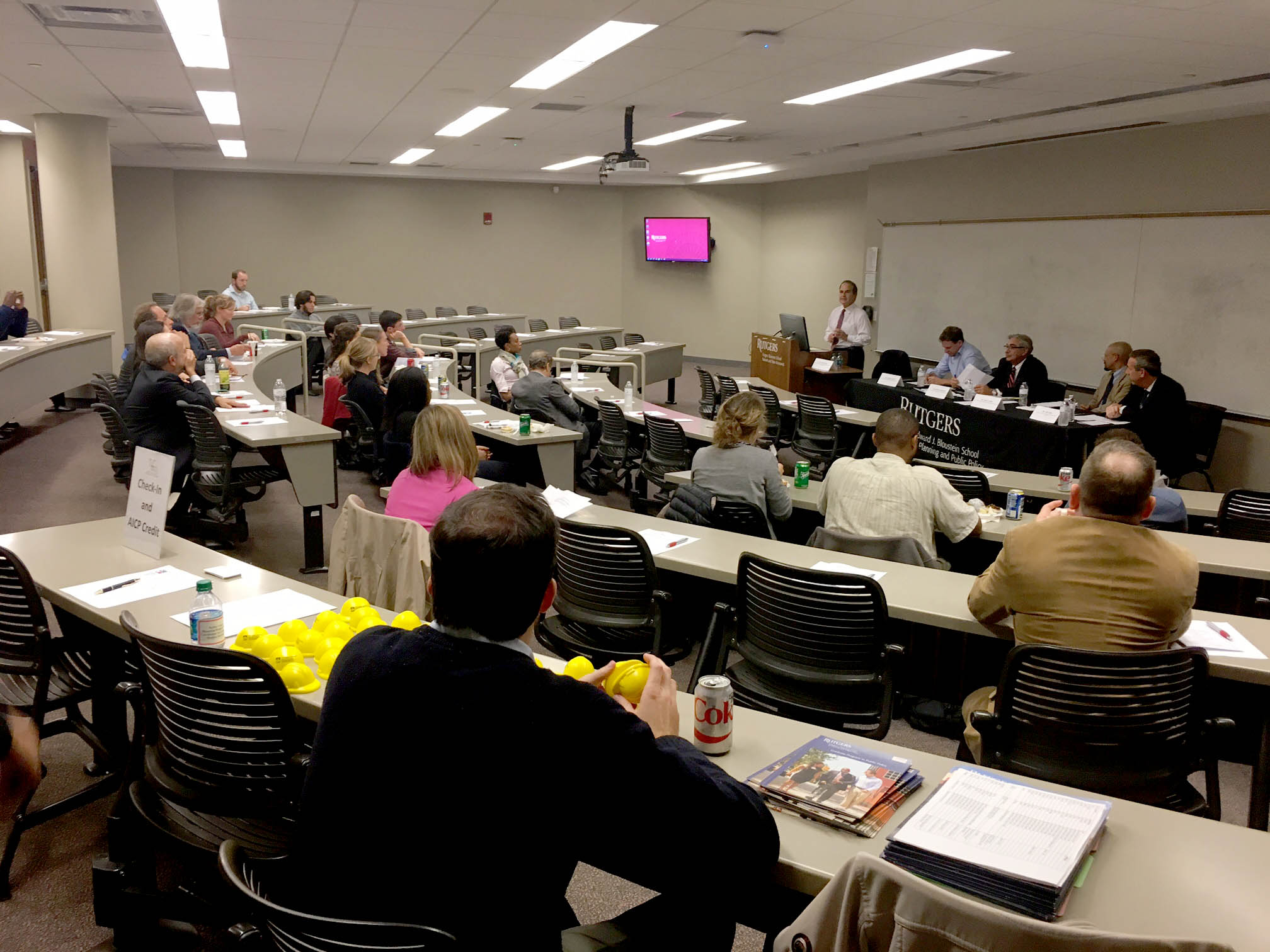 In October Bloustein School faculty, alumni and students attended a PoP Topics panel discussion on dynamic redevelopment in Newark, NJ, held at the Rutgers Business School. Led by Professor David Listokin, the panel members each discussed their particular role in the redevelopment of the historic Hahne & Co. Building in downtown Newark. Following the presentation, attendees were invited to join the panelists in a ‘behind-the-scenes’ look at the Hahne’s building under construction, affording a unique chance to see the inner workings of an active-rehabilitation construction site.
In October Bloustein School faculty, alumni and students attended a PoP Topics panel discussion on dynamic redevelopment in Newark, NJ, held at the Rutgers Business School. Led by Professor David Listokin, the panel members each discussed their particular role in the redevelopment of the historic Hahne & Co. Building in downtown Newark. Following the presentation, attendees were invited to join the panelists in a ‘behind-the-scenes’ look at the Hahne’s building under construction, affording a unique chance to see the inner workings of an active-rehabilitation construction site.
Opened in 1901, the 400,000sf. Hahne & Co. building is a powerful symbol of Newark’s golden age, one that has given generations of Newark residents pride in their community. Vacant since 1986, the building was a gilded symbol of Newark’s economic success that had turned into a painful reminder of the post-industrial struggles. With close to $200 million in restoration and conversion now planned, the building is again becoming a beacon of resiliency and transformation, much like the city it calls home. Highlighting this, Dr. Listokin began the presentation with a short anecdote regarding the initial community outreach for this project, recalling the numerous people who expressed hope that it would “be nice if we could bring that building back.”
Leading the redevelopment efforts is L+M Development Partners LLC, a New York City-based real estate developer that has been on the forefront of socially-responsible development since the 1980s. Jonathan Cortell, L+M Development’s Vice President for Real Estate Development, spoke to the project’s visioning. He stressed the importance of ‘conspicuous community engagement’—especially since L+M Development is based in New York and lacked the local knowledge needed to ensure success for a project that hopes to act as a catalyst for positive community development. He ended his presentation by reframing the project as more than just a local redevelopment opportunity—if done well, he said, the project could be replicable across the country, making Newark a model city once again.
![The Hahne and Co. flagship store and adjacent Griffith Building on Broad Street, Newark. Photo By Hudconja (Own work) [CC BY-SA 4.0 (http://creativecommons.org/licenses/by-sa/4.0)], via Wikimedia Commons](/wp-content/uploads/2016/11/Hahne-bldg.jpg)
The Hahne and Co. flagship store and adjacent Griffith Building on Broad Street, Newark. Photo By Hudconja (Own work) [CC BY-SA 4.0 (http://creativecommons.org/licenses/by-sa/4.0)], via Wikimedia Commons
Scott Blow, Acting President and CEO of Newark Community Economic Development Corporation, next noted how the Newark CEDC was vital in bringing L+M Development Partners on board; his group has continued to push for responsible investment in the city’s downtown core. As the primary agency responsible for highlighting the potential of Newark’s downtown, Mr. Blow stressed the importance of redevelopment efforts ‘catching the market wave’ and the ripple effects a project such as this can have on a city’s retail landscape.
Rounding out the panel—and representing the city’s interest through his role as the Director of Real Estate and Housing for the City—was Julio Colon. Offering a view on the project from the perspective of the city as a whole, Mr. Colon stressed the importance of working with the city and within their established frameworks. To show the city’s commitment to redeveloping the site, Mr. Colon spoke about the various incentives and tax abatements that were offered in order to help make the project more financially feasible.
Following the panel discussion, attendees were invited to meet in the Business School’s lobby for a short walk to Broad St. for a look at the active redevelopment site. Small groups, each led by a panelist or an L+M Development representative, were shown the unique architectural details that were maintained, including original brickwork along the façade. Further inside, the group were shown the main community space, crowned with a beautifully restored, original skylight from the building’s days as a flagship department store. With wooden tile flooring, a subdued black and white color scheme and replica wrought iron railings along the second floor, this retail/public space is sure to attract high-quality tenants and provide the city with a gorgeous new civic destination.
Perhaps the most unique aspect of the mixed-use development is the 57,000sf. of cultural space and art galleries, leased to Rutgers University. Hoping to use the space as both a collaborative classroom and museum-quality display space, the university is continuing its investment in New Jersey’s largest city.
On the upper floors, tour members also saw the new, nearly complete residential spaces, which include multi-bedroom units and smaller, but no less desirable, studio spaces. Boasting cathedral-like ceilings, new stainless steel appliances and refined modern décor, the units are sure to attract a new population of young professionals to a city long overlooked.
Overall, the takeaway from the night was a message of optimistic energy; with institutional and corporate reinvestment in the city and a strong sense of community engagement, the Hahne & Co. building is setting the standard for the future of a redeveloped Newark.
Bloustein School PoP Topics are short discussions of different planning and/or policy (PoP) areas, featuring current projects, ideas, and research. Speakers from various organizations are invited to give short presentations on their areas of expertise within the selected topics. These talks are intended to be high energy, engaging, and fast-paced, and are moderated by Bloustein School faculty and/or staff members.
